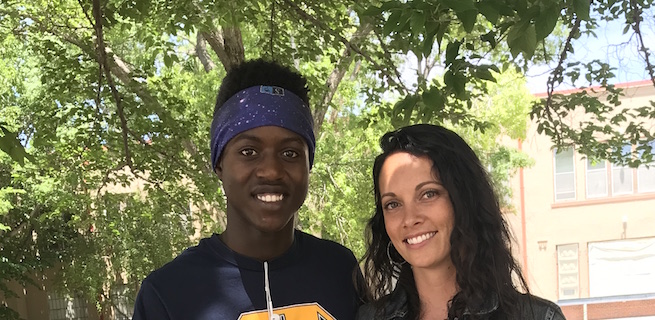How our School System is Failing Immigrant Students
By Rachel White, Refugees of New Mexico, Highland High School | May 10, 2018
In September 2015, Martin enrolled in my high school ESL 1 class as a refugee from Rwanda. He couldn’t communicate with me, aside from telling me “Hi, Miss!” every day with a huge smile on his face. It warmed my heart to feel the enthusiasm that Martin brought with him each day to school. This is one of the things that I love most about teaching English as a Second Language- all my students are New Americans and come to school with the same level of energy, positivity, and the same desire to learn that I felt from my students when I taught kindergarten. The high school students I teach now are new to the United States and are eager to come to school each day so they can achieve the “American Dream” through hard work and education. The system has not gotten to them yet.
Martin is a now a 17-year-old Junior with aspirations to become a medical doctor, but he is struggling to pass his Physics and Algebra 2 classes. He comes to school every day ambitious to learn but isn’t able to grasp the advanced academic concepts. Part of the reason is because he is still learning English and only one of his seven teachers has a Teaching English to Speakers of Other Languages (TESOL) endorsement. This endorsement gives K-12 teachers specialized training to teach for English language development no matter what course or subject they teach.
Martin realizes the dilemma that he is in. The system is starting to get to him. He told me though teary eyes this week that sometimes he gets so frustrated that he wants to go back to Rwanda. He said, “Sometimes I want to go back to my country. I feel really sad, like I came here for nothing. In the refugee interviews, they told me school in America was free and I was really excited. But now I wonder if its free because you don’t learn anything.”
Nationwide, 9.5% of students are considered to be ELs, or English learners. New Mexico has an exceptionally high percentage, with approximately 20% of the student population consisting of ELs. In Martin’s school, ELs make up 33% of the student population but unfortunately, only 9% of the teachers have their TESOL endorsement.
In the Albuquerque Public Schools district, the compensation for having a TESOL endorsement is $500/year, or $19.23/paycheck. However, if you teach English Language Arts to English Learners, you will receive an additional $2,500 stipend for your TESOL endorsement. All elementary classroom teachers teach multiple subjects, so they receive an additional $3,000/year for a TESOL endorsement. It’s no surprise that a much higher percentage of elementary teachers hold a TESOL endorsement. Since middle and high school teachers typically stick with one subject, unless they teach English Language Arts they do not receive the stipend- even though they have ELs in their classes. This is one reason why more of Martin’s teachers, and other teachers around the state, are not endorsed in TESOL and qualified to teach him.
But why wouldn’t a teacher at a school like Martin’s recognize that their students need teachers who hold TESOL endorsements and complete the course work? Well, if you are the only TESOL endorsed teacher in your grade level or subject area, you will have all of the ELs in your class. Not only are ELs traditionally more difficult to teach, but they don’t test as well as their English-speaking peers on standardized assessments, such as PARCC.
Thirty percent of a New Mexico teacher’s evaluation is based on student test scores. If your students do not perform well on the PARCC test year after year, your evaluation will drop. All of the research on ELs shows that it takes between 7-10 years for an EL student to acquire English at the rate of their English-speaking peers. Though the PARCC test is supposed to account for student growth while ELs are learning English, my teacher evaluations still dropped. I received stellar scores on my observations from my principals, but my students’ test scores brought my overall evaluation down a considerable amount.
Many teachers recognize this and decide not to invest in their TESOL endorsement. It is not worth it to them to receive $19.23/paycheck only to have much more work and risk a poor evaluation. If the teachers are working to advance to a higher teaching level, which will increase their pay between $5,000-$10,000/year, they are especially unlikely to take on the “burden” of English learners, who could jeopardize their advancement.
It’s a symptom of a much bigger problem. We suffer from a scarcity mindset in education and it is most apparent in our work with English Language Learners. Many newcomers are a burden because there aren’t enough skilled teachers to go around. Even the most committed teachers will say that they are already struggling to meet the needs of the kids who speak English. And the effect of our teacher evaluation system is to hoard good evaluations for teachers who serve kids who are already competent in English. The lack of resources, real and perceived, is the root cause of our problem in public schools, and ultimately students like Martin are forced to pay the price.


